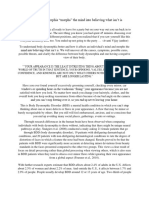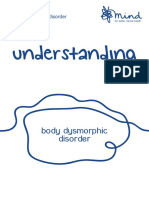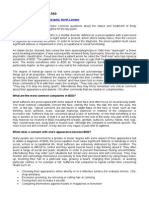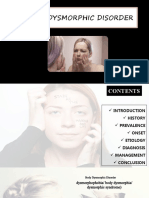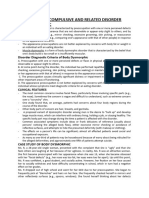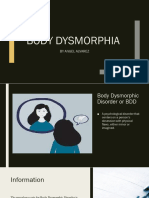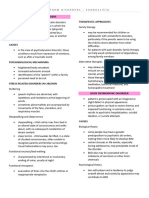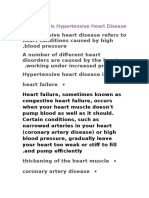Body dysmorphic disorder
Body dysmorphic disorder is a type of chronic mental illness in which you can't stop thinking
about a flaw in your appearance a flaw that is either minor or imagined. But to you, your
appearance seems so shameful that you don't want to be seen by anyone.
When you have body dysmorphic disorder, you intensely obsess over your
appearance and body image, often for many hours a day. Your perceived flaw
causes you significant distress, and your obsession impacts your ability to function in
your daily life. You may seek out numerous cosmetic procedures or excessively
exercise to try to "fix" your perceived flaw, but you're never satisfied. Body
dysmorphic disorder is also known as dysmorphophobia, the fear of having a
.deformity
Treatment of body dysmorphic disorder may include medication and cognitive
.behavioral therapy
Symptoms
Preoccupation with your physical appearance with extreme selfconsciousness
Frequent examination of yourself in the mirror, or the opposite, avoidance of
mirrors altogether
Strong belief that you have an abnormality or defect in your appearance that
makes you ugly
Belief that others take special notice of your appearance in a negative way
Avoidance of social situations
Feeling the need to stay housebound
The need to seek reassurance about your appearance from others
Frequent cosmetic procedures with little satisfaction
Excessive grooming, such as hair plucking or skin picking, or excessive
exercise in an unsuccessful effort to improve the flaw
The need to grow a beard or wear excessive makeup or clothing to
camouflage perceived flaws
Comparison of your appearance with that of others
Reluctance to appear in pictures
You may obsess over any part of your body, and the body feature you focus on may
change over time. But common features people may obsess about include:
Face, such as nose, complexion, wrinkles, acne and other blemishes
Hair, such as appearance, thinning and baldness
Skin and vein appearance
Breast size
Muscle size and tone
Genitalia
You may be so convinced about your perceived flaws that you imagine something
negative about your body that's not true, no matter how much someone tries to
convince you otherwise. Concern over and thinking about the perceived flaw can
dominate your life, leading to absence from work, school or social situations due to
extreme self-consciousness.
When to see a doctor
Shame and embarrassment about your appearance may keep you from seeking
treatment for body dysmorphic disorder. But if you have any signs or symptoms of
body dysmorphic disorder, see your doctor, mental health provider or other health
professional. Body dysmorphic disorder usually doesn't get better on its own, and if
untreated, it may get worse over time and lead to suicidal thoughts and behavior.
Causes
It's not known specifically what causes body dysmorphic disorder. Like many
other mental illnesses, body dysmorphic disorder may result from a
:combination of causes, such as
Brain differences. Abnormalities in brain structure or neurochemistry may
play a role in causing body dysmorphic disorder.
Genes. Some studies show that body dysmorphic disorder is more common
in people whose biological family members also have the condition, indicating
that there may be at least one gene associated with this disorder.
Environment. Your environment, life experiences and culture may contribute to body
dysmorphic disorder, especially if they involve negative experiences about your
body or self-image.
Treatment
Treatment of body dysmorphic disorder can be difficult, especially if you aren't a
willing and active participant in your care. But treatment can be successful. The two
main treatments for body dysmorphic disorder are cognitive behavioral therapy and
medications. Often, treatment involves a combination of these.
Cognitive behavioral therapy
Cognitive behavioral therapy focuses on:
Helping you learn about your condition and your feelings, thoughts, moods
and behavior
Using the insights and knowledge you gain in psychotherapy to stop automatic
negative thoughts and to see yourself in a more realistic and positive way
Learning healthy ways to handle urges or rituals, such as mirror checking or
skin picking
Teaching you other healthy behaviors, such as how to socialize with others
You and your therapist can talk about which type of therapy is best for you, your
goals for therapy, and other issues, such as the number of sessions and the length of
treatment.
Medications
Although there are no medications specifically approved by the Food and Drug
Administration (FDA) to treat body dysmorphic disorder, psychiatric medications used
to treat other conditions, such as depression, can be effective.
Selective serotonin reuptake inhibitors (SSRIs). Because body dysmorphic
disorder is thought to be caused in part by problems related to the brain chemical
serotonin, SSRIs are typically prescribed. SSRIs appear to be more effective than
other antidepressant medications for body dysmorphic disorder and may help
�control your obsessions and repetitive behaviors. Your doctor may increase your
dose on a gradual basis to make sure you can tolerate the medication and
possible side effects.
Other medications. In some cases, you may benefit from taking medications
in addition to your primary antidepressant. For instance, your doctor may
recommend that you take an antipsychotic medication in addition to an SSRI if
you have delusions related to body dysmorphic disorder.
Hospitalization
In some cases, your body dysmorphic disorder symptoms may be so severe that you
require psychiatric hospitalization. Psychiatric hospitalization is generally
recommended only when you aren't able to care for yourself properly or when you're
in immediate danger of harming yourself.
Lifestyle and home remedies
In most cases, body dysmorphic disorder is difficult to treat without professional help.
But you can do some things for yourself that will build on your treatment plan, such
as:
Stick to your treatment plan. Don't skip therapy sessions, even if you don't
feel like going.
Take your medications as directed. Even if you're feeling well, resist any
temptation to skip your medications. If you stop, symptoms may come back. You
could also experience withdrawal-like symptoms from stopping a medication too
suddenly.
Learn about your condition. Education about body dysmorphic disorder can
empower you and motivate you to stick to your treatment plan.
Pay attention to warning signs. Work with your doctor or therapist to learn
what might trigger your symptoms. Make a plan so you know what to do if
symptoms return. Contact your doctor or therapist if you notice any changes in
symptoms or how you feel.
Get active. Physical activity and exercise can help manage many symptoms,
such as depression, stress and anxiety. Physical activity can also counteract the
effects of some psychiatric medications that may cause weight gain. Consider
�walking, jogging, swimming, gardening or taking up another form of physical
activity you enjoy.
Avoid drugs and alcohol. Alcohol and illegal drugs can worsen mental
illness symptoms or interact with medications.
Get routine medical care. Don't neglect checkups or skip visits to your family
doctor, especially if you aren't feeling well. You may have a new health problem
that needs to be addressed, or you may be experiencing side effects of
medication
Complication
Complications that body dysmorphic disorder may cause or be associated with
:include
Unnecessary medical procedures, especially cosmetic surgery
Social phobia and social isolation
Lack of close relationships
Difficulty attending work or school
Low self-esteem
Repeated hospitalizations
Depression or other mood disorders
Suicidal thoughts or behavior
Anxiety disorders
Obsessive-compulsive disorder
Eating disorders
Substance abuse
Cosmetic procedures
While it may seem that a procedure to fix your perceived flaw is a good option, skin
(dermatologic) procedures, cosmetic surgery, dentistry or other approaches usually
�don't relieve the stress and shame of body dysmorphic disorder. You may not
perceive the results you hoped for, or you may simply begin obsessing about another
aspect of your appearance and seek out more procedures.
Risk factor
Although the precise cause of body dysmorphic disorder isn't known, certain factors
:seem to increase the risk of developing or triggering the condition, including
Having biological relatives with body dysmorphic disorder
Negative life experiences, such as childhood teasing
Personality traits, including low self-esteem
Societal pressure or expectations of beauty
Having another psychiatric disorder, such as anxiety or depression
Body dysmorphic disorder usually starts in adolescence. It affects males and
females.
Diagnosis
If your doctor or mental health provider believes you may have body dysmorphic
disorder or another mental illness, he or she typically runs a series of medical and
.psychological tests and exams to help pinpoint a diagnosis
These exams and tests generally include:
Physical exam. This exam can help clarify other problems that may be
associated with your symptoms.
Lab tests. Lab tests may be ordered by your doctor, depending on your
overall health or other problems associated with your symptoms.
Psychological evaluation. A doctor or mental health provider talks to you
about your symptoms, thoughts, feelings and behavior patterns. You may also
discuss any thoughts you may have of self-harm.
Pinpointing which condition you have
It can be difficult to diagnose body dysmorphic disorder, as it may be similar to or
overlap with other psychological conditions, such as an eating disorder or obsessivecompulsive disorder. Also, you may be so embarrassed about your appearance that
�you avoid medical help, don't reveal your true feelings to doctors or don't even realize
that your body image is distorted. It can take some time and effort to get an accurate
diagnosis so you can get appropriate treatment.
Diagnostic criteria for body dysmorphic disorder
To be diagnosed with body dysmorphic disorder, you must meet the symptom criteria
in the Diagnostic and Statistical Manual of Mental Disorders (DSM). This manual,
published by the American Psychiatric Association, is used by mental health
providers to diagnose mental illnesses and by insurance companies to reimburse for
treatment.
Symptom criteria required for a diagnosis of body dysmorphic disorder include:
Being extremely preoccupied with an imagined defect or a minor flaw in your
appearance
Being so preoccupied with appearance that it causes you significant distress
or problems in your social life, work, school or other areas of functioning
Effects
It is not uncommon for a person with body dysmorphia to intensely obsess over her
appearance and body image, often for many hours a day. She may seek out
numerous cosmetic procedures to try to fix her perceived flaws but will never be
.satisfied
A person may change which body feature is the center of focus over time. She may
be so convinced about her perceived flaws that she begins imagining something
about her body that's not true, no matter how much someone tries to convince her
otherwise. Similar to anorexia nervosa and other eating disorders, the intense
subjective and implacable nature of this condition can cause it to be very trying for
those close to the person. The intensity of shame and embarrassment about her
.appearance that body dysmorphic disorder causes cannot be overstated



